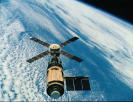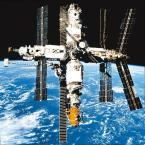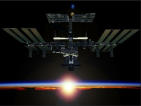



Living inside a space colony will, in many ways, be like living on Earth. People will have houses or apartments. They will go to work and to school. There will be shops, sports teams, concerts and movies. People will go to parties with their friends, just like on Earth. But there will be differences as well.
Today we live on the outside of a planet. Earth is thousands of kilometers across, so big that it looks like we are living on a flat surface. Instead of living on the outside of a huge planet, space settlers will live inside very large spacecraft. Large enough to take a good walk, but not so big that it will look like you live on a flat surface. People will live on the inside of spheres, cylinders, and toruses (a donut shape). These shapes are ideal for space colonies because colonies must rotate to produce pseudo-gravity, and the main living areas must be equidistant from the axis of rotation so the 'gravity' doesn't change as you move around. Pseudo-gravity is necessary because space colonies have far too little mass to produce much real gravity, but something like gravity is needed for bones and muscles to stay strong. Since most colonies will only be a few kilometers across, the curve of the hull will be easy to see. Unlike Earth, however, which curves down, when you look around the neighborhood in a space colony the land will curve up.
There is another big difference. The air and water we need to live is recycled on a huge scale here on Earth, and we don't need to work too hard for that to happen. On a space colony, millions of times smaller than Earth, we will need to constantly monitor the air and water and take quick action if anything begins to go wrong. Here on Earth CO2 levels are rising and some are concerned that decades from now global warming will become a serious problem. On a space colony, rising CO2 levels will cause an immediate alarm and require fixing within hours to avoid the entire population suffocating. Every space colonist will be a rabid environmentalist by absolute necessity.
On a space settlement, recycling will be a way of life. Here on Earth many people feel we can use things and throw them away. There are plenty of materials all around us. On a space colony, every atom is precious. Nothing, except perhaps the most toxic of toxic wastes, will be thrown away. Everything will be endlessly recycled, especially water. Waste water won't go out to the sea. It will run to the outside where sunlight will sterilize the waste, and then everything will be recycled through the agricultural section.
Agriculture will be different too. On Earth, huge farms take advantage of natural conditions to grow the food we need to live. On a space colony, there are no natural conditions. Food will be grown in small, carefully controlled rooms where conditions are kept perfect for the crops being grown. This will lead to very high yields so the area needed for agriculture will be far smaller than on Earth. Furthermore, plants in the agricultural modules will be integrated into the atmosphere maintenance systems since plants produce oxygen and consume CO2.
The further big difference will be low and zero-g recreation. On Earth, we always feel the pull of gravity and it's always the same amount (1g, the 'g' stands for gravity). On a rotating space colony, people just on the inside of the hull will feel a pull a lot like gravity and the amount will be 1g. However, as you go closer to the center of the colony the pull will gradually decrease until it's 0g right at the axis of rotation. This will be a lot of fun. Jumping 20 meters will be easy, even for the most out-of-shape colonists. Gymnasts and dancers will experience freedom of movement they could never have on Earth. New sports will be created to take advantage of freedom from gravity, and old sports will change to adapt to the new conditions. Baseball, American football, and basketball won't work very well in 0g, but they will still be played just inside the hull where 1g rules. However, soccer (called football outside the U.S.) can be easily adapted to 0g and we can expect some very exciting, and wild, 0g games.
No one has ever built a space colony, and it is sufficiently difficult that it will be many years before that happens. Mankind has, however, been building space stations for decades. Space stations aren't homes, they are work camps, like the ones used to build the Alaska pipeline. Nonetheless, space stations are real today, so it's worth taking a look at what we've done.
| Skylab | Salyut 7 | Mir | ISS |

|

|

|

|
From the space colonization point of view, however, the most important Skylab result may have been home movies of astronauts playing in the weightlessness (click here for online videos). Weightless recreation is a major feature of space colonies. Skylab was pretty big, big enough for gymnastics. None of the astronauts were particularly good gymnasts, but in 0g that's not really a problem. The Skylab home movies show three men running around the ~20 meter circumference of the station, going upside down, doing flips, hand springs, multiple-twists and all kinds of moves they would never try on Earth. One of the fun things about space colonization is that almost anyone, even those with fairly severe physical disabilities, will be able to do this.
Skylab lives on the web at Kennedy Space Flight Center, Goddard Space Flight Center, and Marshall Space Flight Center.
In February 1985, while Salyut 7 was flying unmanned, ground control accidentally cut off communication with the spacecraft which was left without any ground control and effectively disabled. In June 1985 a rescue crew was sent to Salyut 7. After a manual docking, they found the station without lights, power, heat or working communication equipment. All the water had frozen. The crew, however, was able to bring the station back from the dead and into operational status.
Ultimately, Salyut 7 was visited by 10 crews totaling 22 cosmonauts, including missions of over 200 days, paving the way for the next big improvement in space stations.
For more information on the Salyut space stations see Encyclopia Astronautica and the Russian Space Web.
With the collapse of the Soviet Union, the Russian space budget was drastically cut. To bring in cash, the Russians agreed to launch the first space tourist, Dennis Tito, to the Mir near the end of its life. Mr. Tito is reputed to have paid $20 million for the privilege. Before he could go however, the Russians de-orbited the Mir. They couldn't afford to operate the Mir and work on the new International Space Station they were building with the Americans at the same time.
Instead of visiting the 10 year-old Mir, Mr. Tito flew to the brand new International Space Station. His glowing accounts of the visit played an important role in establishing space tourism as a potentially profitable business.
For more information on the Salyut space stations see the Mir articles in the Encyclopia Astronautica and the Russian Space Web.
NASA maintains a web site with extensive ISS information.
Since space colonies are for permanent living, not just a few month's work, they must be much larger. In this article we will discuss several space settlement designs, all include habitable areas a kilometer (nearly a mile) or more in size. This is much larger than the space stations described above, which are all a few tens of meters long at best. Thus, orbital space settlements are expected to be about 100 times larger than today's space stations.
Space stations have small crews, usually only a few people. Supplies of air, water, and food can be brought from the ground with limited recycling. The colony designs we examine here are for thousands of people, and this means there are a few minor problems to solve :-). For example, space has no air, no water, no food and it's way too difficult to bring enough up for thousands of people. In addition, in the sun it is far too hot and in the shade it's unbelievably cold. There's also quite a bit of radiation. All the great stuff the Earth provides more-or-less for free: air, water, reasonable temperatures, radiation protection, and even gravity need to be provided by the space colony.
The first priority is something to breathe. The colony must be filled with air and the hull (the outermost shell) must be air-tight. If the hull leaks much, the colony will lose its atmosphere and become unlivable. Since outside the hull is a vacuum, the atmosphere on the inside will push outwards on the hull, which must be strong enough to withstand the air pressure. At sea level on Earth air pressure is about ten tons for every square meter (roughly a square one yard on each side). However, people can breathe perfectly well in the mountains where the air pressure is much less, so less dense air pushing with six to seven tons per square meter should be adequate. Fortunately, we have been building small, air- tight spacecraft for over forty years now, we just need to make them bigger. Unfortunately, just being strong enough to hold the air in isn't enough. To get something resembling gravity we need to spin the colony and that puts even more stress on the hull.
Astronauts in the ISS don't weigh anything. They just float around, which is great fun. However, even though astronauts exercise for hours every day, weightlessness causes muscles and bones to atrophy. Our bodies only stay strong when they work, and removing the stress of Earthly gravity reduces the workload a great deal. Some astronauts become so weak they can't stand up when they get back to Earth.
No one has any idea what would happen to children raised in weightlessness, but it's a safe bet they will never visit Earth, even for an all-expense scholarship to Harvard. Without the stress placed on a growing body by Earth-normal gravity, bones and muscles will have no reason to develop strength and power. Fortunately, we can get something that feels a lot like gravity by rotating our colonies. This is called pseudo-gravity. Living in Earth-normal pseudo-gravity should allow adults to keep their strength and children to develop it. The need for pseudo-gravity puts additional stress on the hull, but, as luck would have it, we already know how to make materials that are plenty strong enough.
Currently available materials are perfectly adequate to build colonies up to a few kilometers across or so. This is about the size of a California beach town. A population of ten or twenty thousand will fit quite nicely. Credible designs even exist for colonies many tens of kilometers across with populations in the millions, but the first colonies will almost certainly be smaller.
Orbital space colonies can come in many sizes, but the need to rotate to get pseudo-gravity means that only a few shapes work really well. Specifically: balls, cans and donuts; more formally called spheres, cylinders, and toruses. It's also possible to combine shapes; for example, you can attach many toruses together - like stacking donuts - to get a colony shape called the 'crystal palace'. Each shape has its advantages and disadvantages and different groups of colonists may be expected to choose different shapes depending on their needs and desires.
The simplest shape is the ball or sphere. This has the advantage of having the minimum surface for any fixed volume. This is an advantage because the exterior must stop the radiation so common in space. The simplest way to stop the radiation is just to pile enormous amounts of material, anything will do, on the outside. You need roughly five tons for every square meter of surface. Since the sphere has the smallest surface area for whatever volume one needs, the amount of radiation shielding is minimized. Since all the shielding must be imported from the Moon or NEOs, this can save a lot of work.
NEO stands for Near Earth Object. NEOs are asteroids and comets that pass near Earth. There are about a thousand of these one kilometer across or bigger, and many millions of smaller ones. Some NEOs are actually easier to get to than the Moon, so they may be a great source of materials.
Note: this section includes 3D models of space colonies that you can view if you have a VRML plugin for your web browser. One such plugin is the Cortona VRML Client, which is free. All the VRML for this page was produced by Nittin Arora and Ankur Bajoria.

| 
| 
| 
| 
|
Any spherical colony, including the Bernal Sphere, has a significant disadvantage. Orbital colonies must spin to create pseudo-gravity to keep the inhabitants strong. The amount of pseudo-gravity you experience depends on how far you are from the axis of rotation. In a sphere, the axis of rotation must pass through the center of the sphere. The closer to the axis of rotation you are, the less pseudo-gravity you experience so the less you weigh. The further from the axis the more you weigh. No fair saying your diet is working simply by moving closer to the center.
In general smaller colonies are easier to build than larger ones, so you generally want to make colonies just big enough to get 1g at the furthest point from the axis of rotation. In a spherical colony, only a single great circle on the hull is the maximum distance from the axis of rotation. Everyplace else will be at a lower pseudo-gravity level. Unless you are very careful how you move about, your weight will be constantly changing. This can be fixed by placing a flat floor across the sphere on both sides of the axis of rotation, but then the space below the floor must be at higher than 1g pseudo-gravity levels.

| 
| 
| 
| 
|
There are disadvantages as well. First of all, there is far more surface area than other shapes, so much more radiation shielding is needed. This substantially increases the mass. Also, a simple torus has no livable space in the center where you can have weightless recreation. This is a big one. Remember that the pseudo-gravity you feel depends on how far from the axis of rotation you are. The further away, the more you weigh; the closer the less. Right at the center you don't weigh anything at all - just as if there was no rotation. Since one of the great things about living on a space colony is weightless recreation, a simple torus is not a viable approach. Most toroidal orbital colony proposals feature spheres or cylinders at the center to provide 0g fun for the inhabitants. This however, increases the surface area of the colony even more, which requires more radiation shielding.

| 
| 
| 
| 
|
| VRML | VRML | VRML |
Lewis One has a large, non-rotating shielding cylinder with three sections inside. One is the main rotating habitat. The second is non-rotating for 0g industry and tourism. The third is unpressurized and is sized to build more rotating sections. Thus, Lewis One is specifically designed to build more colonies.
To the space settlement home page.
Author: Al Globus. VRML by Nittin Arora, and Ankur Bajoria.